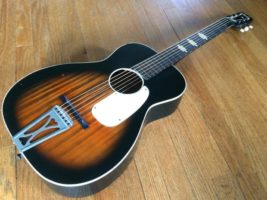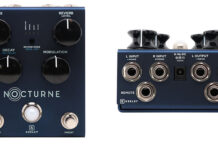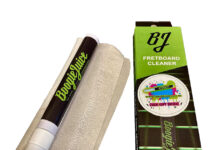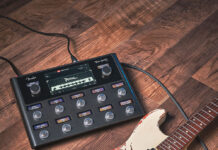
Flea Market Guitar Review: Blues-Approved 1963 Stella Acoustic Guitar
If you ever trip over one of these old Stella acoustic guitars at a flea market, buy it!
I bought this 1963 Stella acoustic guitar for $20 at Campbell’s Music Store in York, PA last week. Bob Campbell didn’t even have a price tag on it. (I think he had it hanging there out of mere curiosity.) The guitar’s condition was atrocious. It had:
- A bent tuner (and the other tuners were hard to turn)
- Four remaining strings
- Two cracks in the soundboard
- Decades of grime
- A cracked nut
And yet, I feel like I was the winner in the deal. Here’s a little demo.
These bottom-of-the-line Stella model #H929 folk acoustic guitars were sold by the thousands from the Forties through the Sixties in music stores, department stores and through catalogs. This one is stamped “F-63 FK” inside the sound hole, designating a guitar that was built in the fall of 1963. The FK stands for Folk Guitar.

It’s easy to spot these guitars in a junk pile. They have tobacco-burst paint jobs and painted binding with an airbrushed tiger stripe soundboard (yes, the stripes are painted on: see below), a contrasting white pickguard, stenciled fret markers and a headstock with the classic Stella logo, a white star and the proud claim of a “Steel Reinforced Neck—Made in America.”

Notice the painted-on woodgrain.
However, don’t be fooled by the guitar’s appearance. They’re fantastic blues machines, especially for Delta blues slide guitar.
The secret to Stella’s midrange blues tone: Every sound-searching guitarist needs to own at least one old Stella. These Sixties models featured solid soundboards made from slab-sawn birch and feature ladder bracing. When you mix those details with a floating bridge and trapeze tailpiece, you have a guitar that captures glorious midrange. Don’t expect a high end snap like a Martin. Stellas moan. The best way to describe them is the blues guitar sounds from an old 78 record.
The Stellas cranked out in the Sixties came from the Harmony factory in Chicago and feature poplar necks with a non-adjustable steel reinforced neck. The necks are usually warped a bit, which—to a slide guitarist—means they’re broken-in like an old pair of jeans!
Side note: Dear guitar manufacturers, you all have been creating new versions of old guitars, but none of you has brought back birch soundboards. I dare one of you to do it.
Specs for guitar nerds: This Stella features a full scale 24 ¼” neck. (They also came in 23” scale, too.) The width is 13 ¼”, length is 35 ¾ and the body depth is 3 ¾”. Fret markers and headstock logo are screen printed or stenciled on and the body binding is painted.

Repairs I made on my $20 guitar:
- The soundboard cracks were simply patched up from inside using thin wood scraps and Titebond II glue. You can still see the cracks (photo below), but for a $20 guitar, the soundboard is now stable.
- The whole guitar was cleaned with Meguiar’s Auto Quik Detailer and the fretboard was wiped down with lemon oil.
- I haven’t replaced the tuners yet, but I will probably have to do so eventually. They were a bitch to turn, but I was able to tune the guitar to an Open D chord.
- I added a new set of acoustic strings.
- The nut remains cracked and it causes the G string to buzz like a sitar. Like the tuners, this will also have to be replaced, too. For now, I am using a “poor man’s nut replacement” (a.k.a. capo at the 2 fret).

The guitar sings beautifully. When you buy an old dog like this, you expect to make many repairs. Luckily, you’re not repairing a fine instrument that requires the extensive knowledge and tools of a luthier. Stellas afford the common man an opportunity to try his own DIY repairs.
They also deliver a fantastic tone you can’t find from any other guitar. Yes, you can find them priced $200 and up online, but it’s even more thrilling to discover one in the wild…at a flea market or yard sale. If you see one of these old Stellas, buy it!
Especially if it’s only $20.
Musician and author, Shane Speal is responsible for the resurgence of cigar box guitars in modern music. He fronts the DIY-instrument band, Shane Speal and the Snakes, curates the Cigar Box Guitar Museum inside Speal’s Tavern in New Alexandria, PA, and has made 2,000 cigar box guitars to date. His latest book, Making a Poor Man’s Guitar, (Fox Chapel Publishing, August 2018) combines DIY instrument projects with their deep blues history.
Source: www.guitarworld.com










